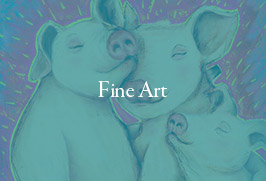doggieDO-GOODers—Case Study
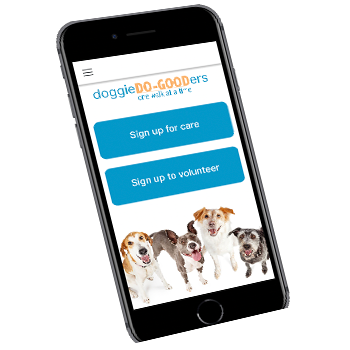
Project Type: Hypothetical
My Role: Product Designer
My Contribution: End-to-end product design lifecycle
Methodologies: Lean UX and Design Thinking
Tools Used: Miro, Figma, Trello and Maze
Background
In cases where people are injured or sick and unable to care for their pet, I want to prevent them from losing their animals when they don’t have to. It’s only a matter of finding someone to help take care of the animals so that the health and mental benefits of owning that pet won’t be lost, and animal shelters won’t get overwhelmed.
Problem Statement
A person who is sick or elderly feels devastated that they cannot take care of their pet. They desperately want to do so, but they lack the ability or resources to accomplish the task.
Project Vision Statement
The doggieDO-GOODers service is for elderly and sick individuals who have dogs, but need help taking care of them because they’re too sick to walk them, or even feed and/or take them to vet/grooming appointments. The platform is an app that connects these individuals with healthy, able bodied, and willing walkers and caretakers.
Unlike the handful of local organizations who offer walking and transportation service, our product will encompass those services, plus more. And unlike ResQWalk, CharityMiles, or WoofTrax, who offer walkers the ability to raise money for a choice of charity, our product will provide the ability to raise funds from walks to either the general doogieDO-GOODers service, or to a specific client of the service.
Goals and Outcomes
- There is to be a benefit to society in that sick and elderly individuals who are enabled to keep their pets, will have their mental well-being, and that will help their physical health as well.
- The economic impact will be that there will be less animals given up, meaning shelters and rescues will have more funds to help animals that have been found as strays.
- The technology to support this app will be developed. Given that there are apps out there that function similarly to what doggieDO-GOODers will do, it is feasible.
Research
The research began with a competitive analysis to understand the market and what the app might potentially function and look like, and ended with a S.W.O.T. analysis.
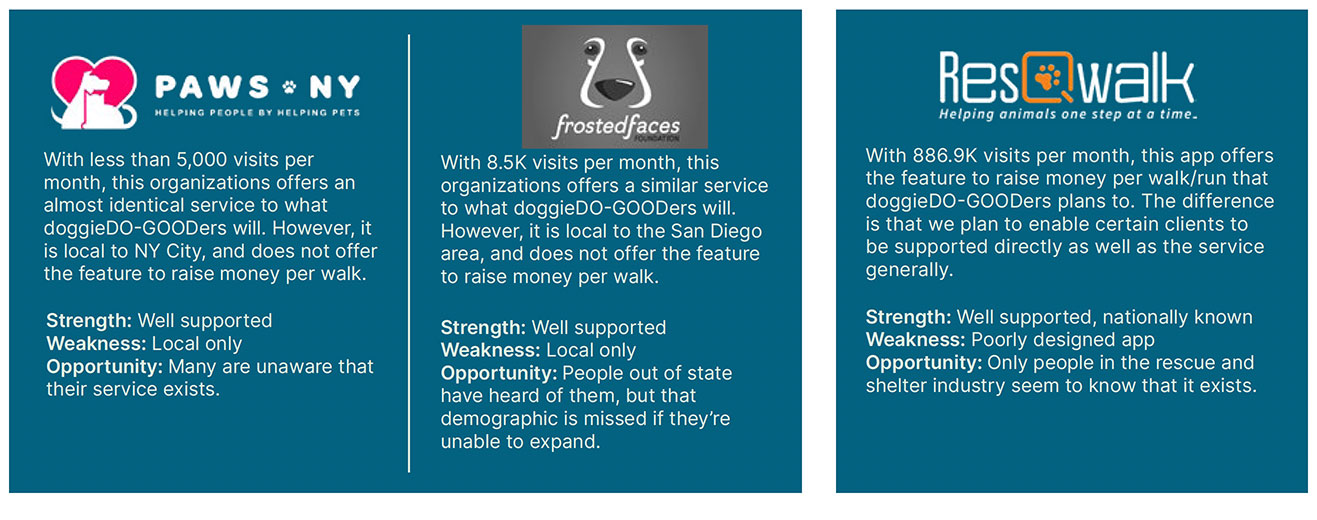
After which, I was able to determine the threats, strenghts, and opportunities.

Once I understood the market, I needed to learn who my users were going to be. I began with user interviews, and spoke with a total of 16 participants. These included shelter administration, shelter volunteers, and service recipients.
Upon completing the interviews, I discovered the following:
- All of the participants interviewed would use a service helping the elderly and sick get help with their pets.
- Most participants felt that reliability and trustworthiness were extremely important for this service to work.
- All the participants interviewed confirmed that there is a dire need for volunteers to help sick and elderly with their pets.
- The volunteers interviewed confirmed they are willing to ensure pets stay with their guardians by volunteering to care for the animals.
Target Audience
- Sick/elderly individuals
- Dog walking/pet care volunteers.
With that knowledge, coupled with the results of the user interviews, I was able to build the empathy map
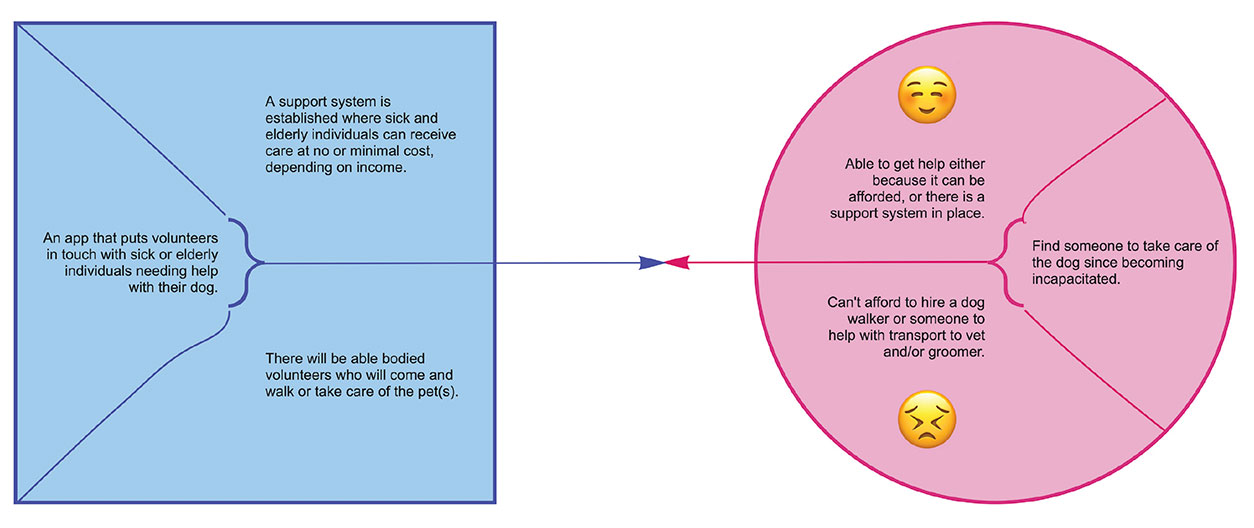
Personas
Janet (volunteer)

Jane (service recipient)
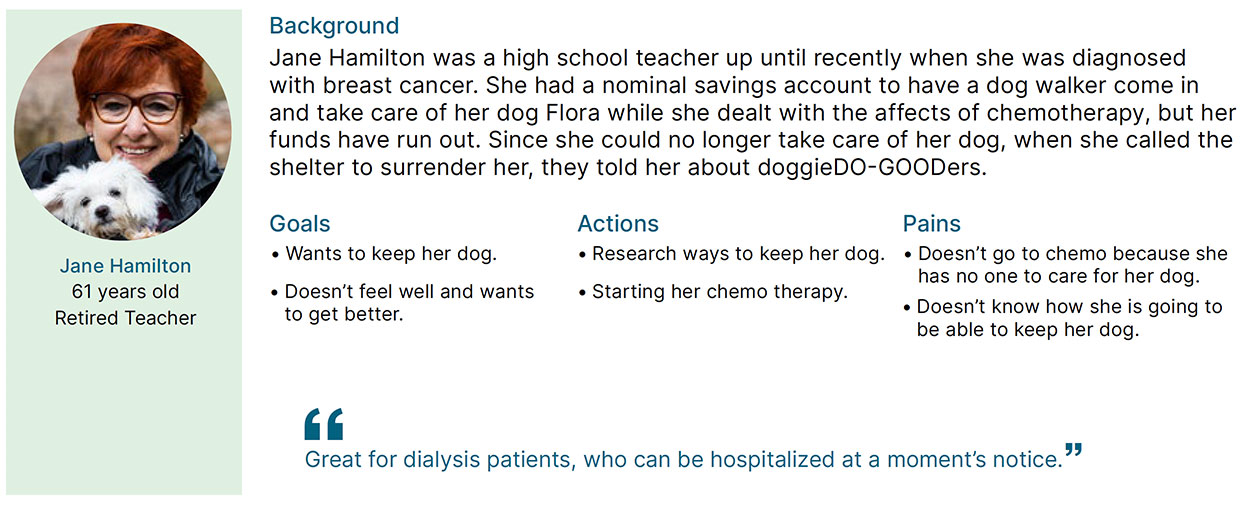
User Stories
Janet (volunteer)
- As a volunteer, I want to input my availability to care for pets so I can make my own schedule and still help out.
- As a volunteer, I want to look up requests for care at my leisure so I can still volunteer, but on my own terms.
- As a volunteer, I want to see my bookings so I can start helping people keep thier pet.
Jane (service recipient)
- As a client, I want to find a volunteer to care for my dog so I can focus on taking care of myself in order to get better.
- As a client, I want to make sure the volunteer I select is trustworthy so I can feel secure about letting them take my pet out of my sight.
- As a client, I want to sign up and see if I qualify, so I can start looking for a volunteer to care for my pet.
- As a client, I want to schedule care for my dog and my home so I can rest and relax knowing my dog is well taken care of.
Journey Maps
Upon determining what the user preferences were and what each individual needed, I was able to create journey maps to better understand the emotional journey of each user.
Janet (volunteer)
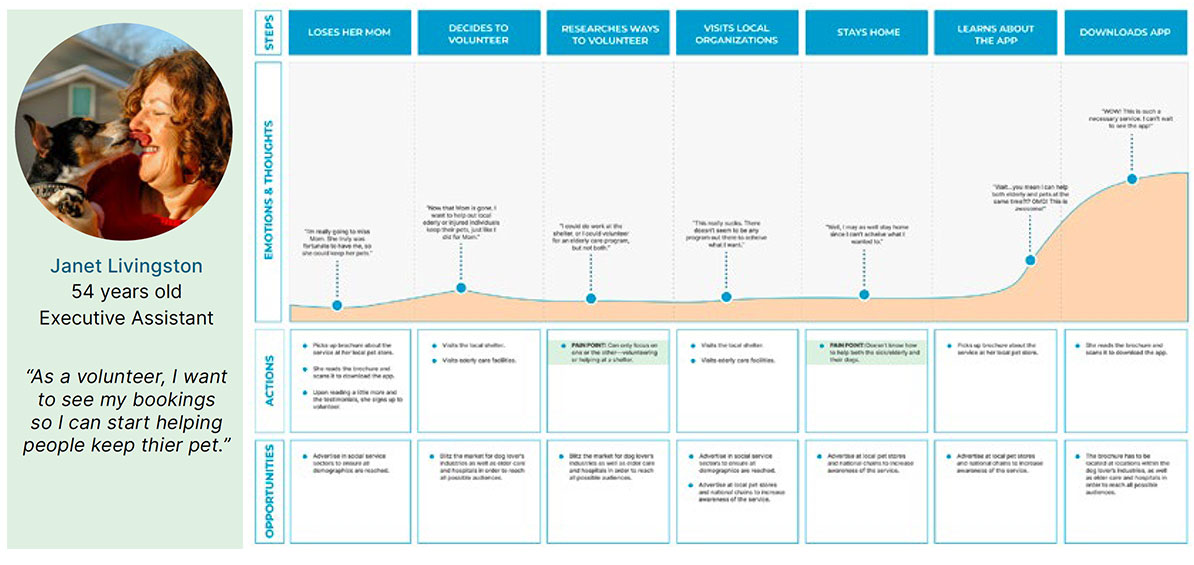
Jane (service recipient)
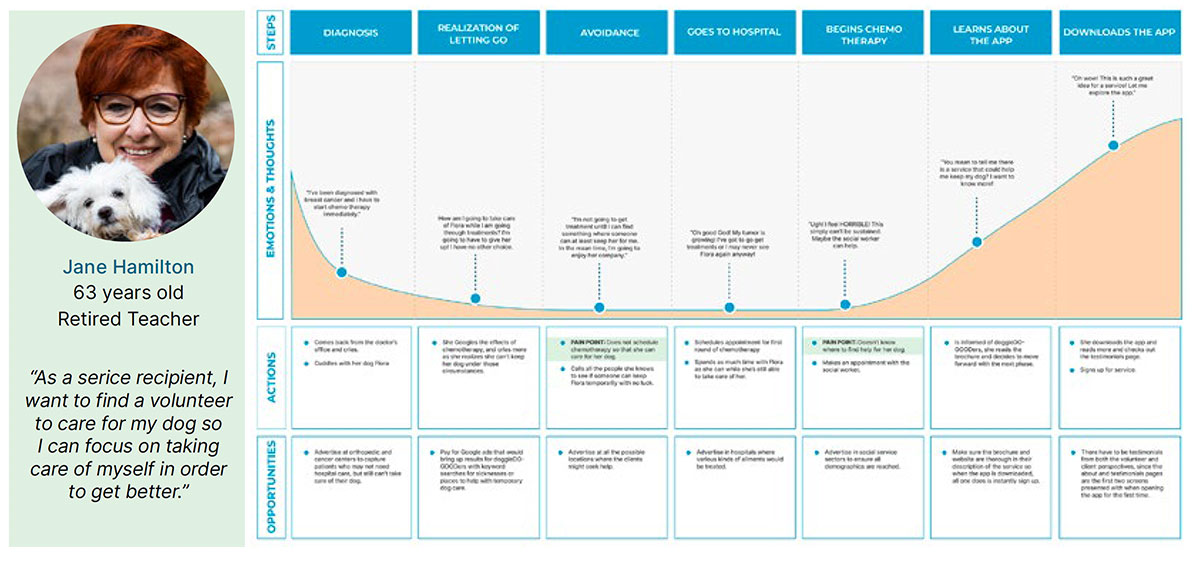
Wireframes
Once I understood what each user was feeling, along with their needs and preferences, I began to work on the rough wireframes for the app.
Janet (volunteer)

Jane (service recipient)

Design Systems
Now that I knew how the app would function, it was time for the best part...the design system!
Typography and Colors
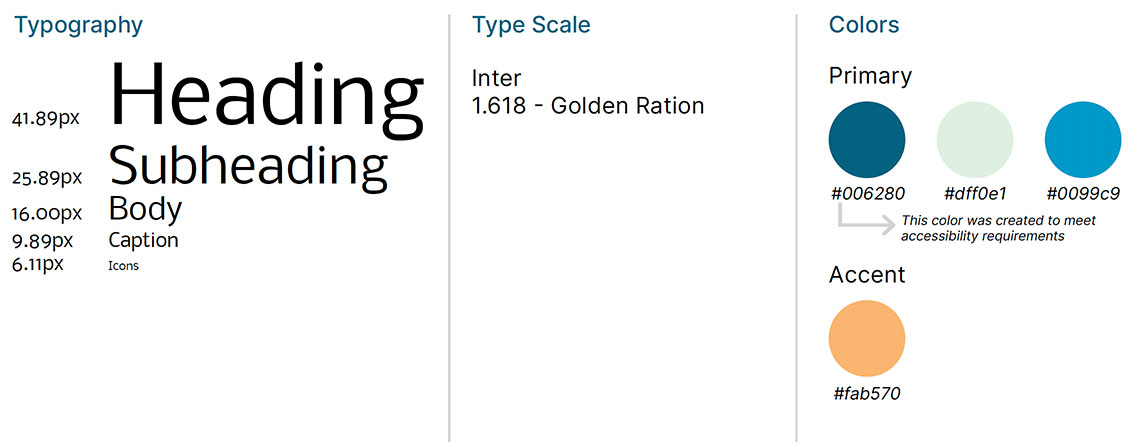
Logo and Components
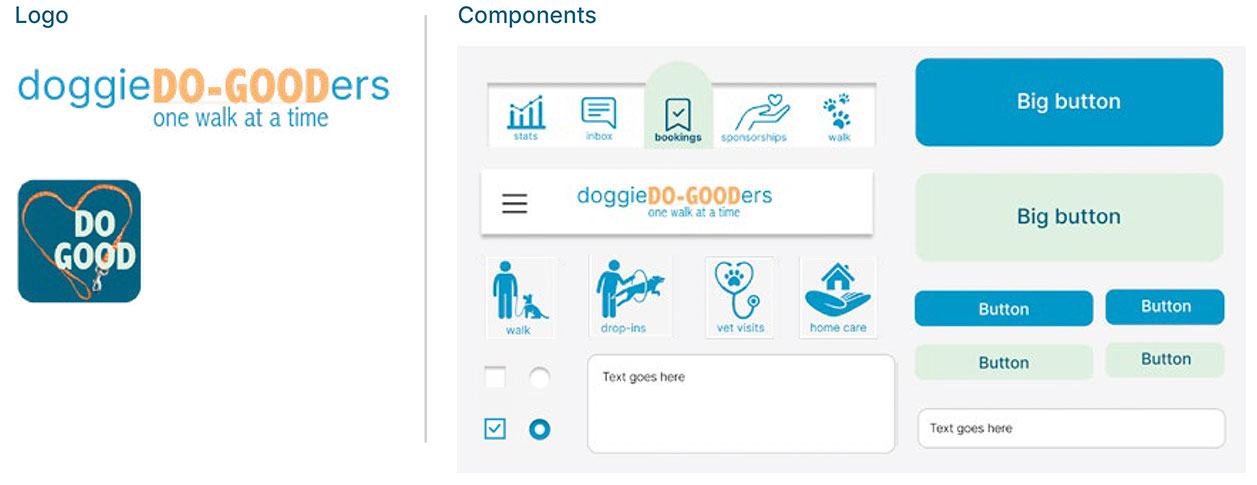
Prototype
Once I had established the branding and design system, I then began to develop the prototype.
User Testing
6 participants were interviewed and asked to use the app to see how it functioned.

Key Learnings
- Three places where all but one user needed help to get through to the next step.
- All said overall, the app was easy to navigate.
- There was some confusion on the volunteer home page. It needs to be booking related as opposed to walking.
Testing Results
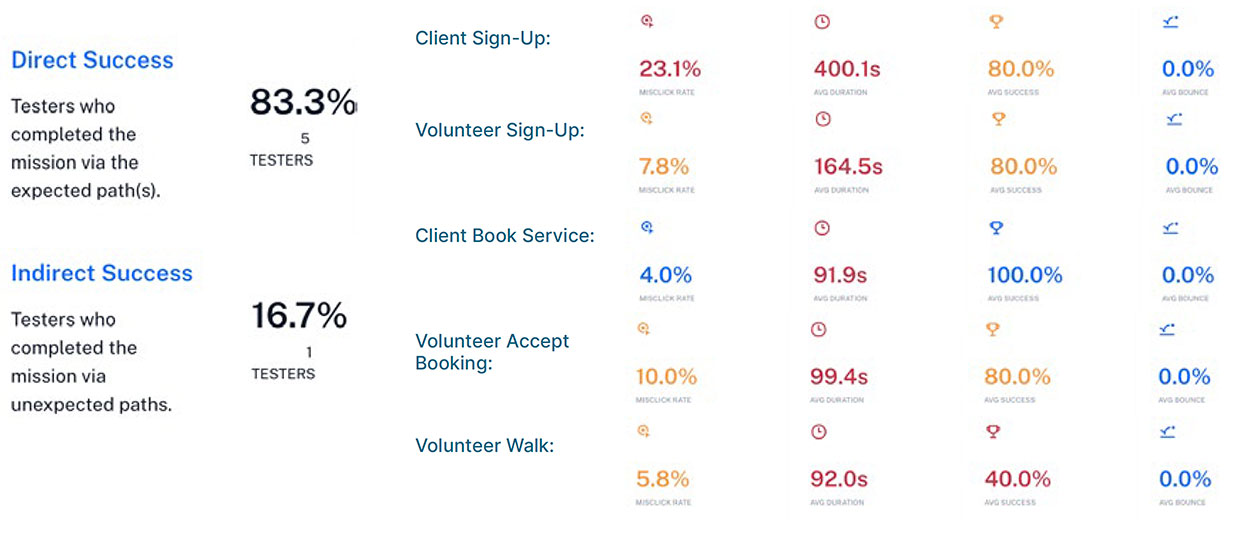
Prototype Iteration
For the forms, I changed the checkboxes and the radio buttons so it was more clear when they are selected. A progress bar to show where one is in the process was also added.
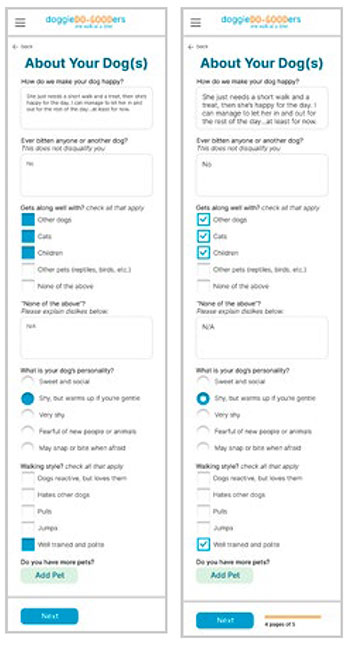
The footer was replaced, and the reschedule and cancel options were made less prevalent since they’re secondary actions.
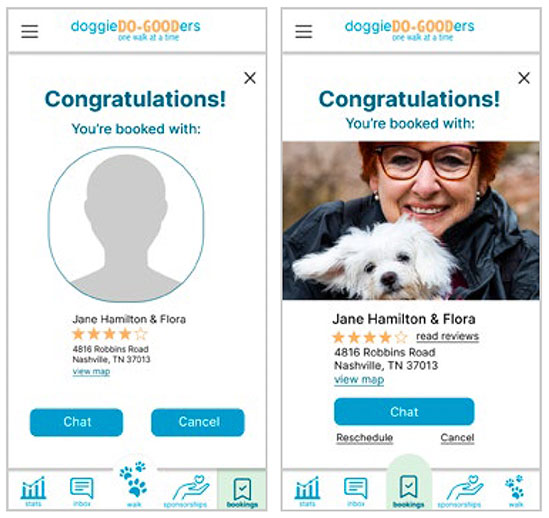
Reflections and Next Steps
Reflections
Several things were discovered over the course of the product development. First, a social worker reported that there is a glaring hole in the system in that the sick and elderly need house and yard care help as well. I also found that volunteers want recognition and community just as much as a typical worker. I discovered where similar organizations obtain their funding from. Some issues that need to be resolved are there needs to be a liason between the service recipients and the volunteers. Finally, I realized that shelter administrators were open to allow doggieDO-GOODers to advertise the services in their establishments.
Next Steps
- Consult a lawyer regarding the legal implications of entering people’s homes and also learning about their health issues.
- Develop the prototype further so the donate, chat, and sponsor features work.
- Implement all the suggestions set forth in the first round of user testing.
- Continue the second round of usability testing.
The final prototype can be found here.



